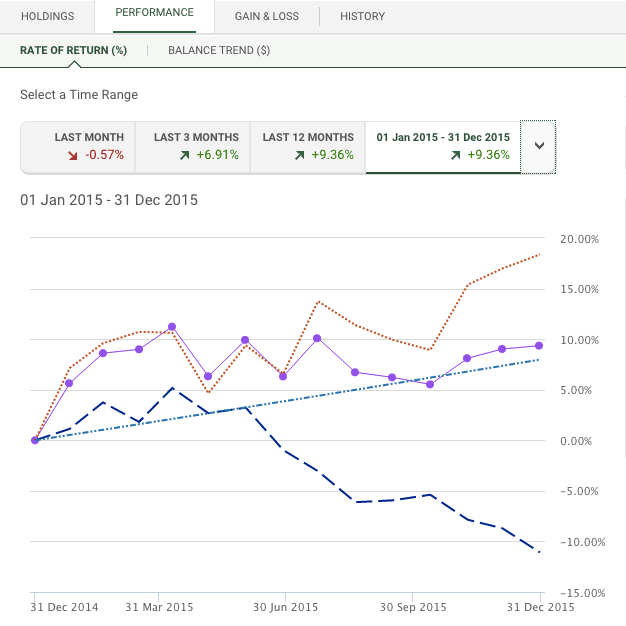Every year I track my portfolio rate of return to see how my investments measure up to specific benchmarks. Prior to 2015 I invested primarily in Canadian dividend paying stocks and measured my stock-picking prowess against the iShares Canadian Dividend Aristocrats Index ETF (CDZ).
Last year I sold all of my dividend stocks ($100,000 in total) and bought $25,000 worth of VCN – Vanguard’s FTSE Canada All Cap Index ETF – and $75,000 worth of VXC – Vanguard’s FTSE Global All Cap ex Canada Index ETF.
As I mentioned in my net worth update, the timing couldn’t have been better as VXC gained 14.76% while the Canadian markets were deep in negative territory. VCN was down 9.29%, and my old benchmark – CDZ – was down 7.86%.
The total rate of return on my TD RRSP investment portfolio in 2015 was 9.36%.
My historical rate of return for this portfolio:
- 2015 – 9.36%
- 2014 – 8.53%
- 2013 – 13.62%
- 2012 – 12.34%
- 2011 – 9.82%
- 2010 – 35.54%
TD recently upgraded its WebBroker platform and introduced some fancy new graphs, charts, and statistics – including new performance measurement tools. Take a look at how my portfolio compares to the TSX Composite Total Return Index (-11.09%) and the S&P 500 Total Return Index (+18.38%).

I’ve also included an 8 percent expected return as my annual target (before fees and inflation). That’s the number I use for my own retirement projections over the very long term, which I consider reasonable for a low-fee, broadly diversified, all-equity portfolio.
Tangerine RRSP account
Back in February I took advantage of a promotion from Tangerine to get an RRSP loan at 1.5% interest. The caveat was that I had to keep the money invested with Tangerine while I paid back the loan, or else face a stiff penalty for transferring the funds.
So I did that and invested $8,210 in Tangerine’s Equity Growth Portfolio – a mutual fund with 50% allocation to Canadian stocks, 25% allocation to U.S. stocks, and 25% allocation to International stocks. The fund comes with a 1.07% MER.
Unfortunately, the heavy exposure to Canadian stocks meant a dismal performance for this fund and it lost 2.9 percent for me on the year. With the loan now paid off I will liquidate this fund and transfer the money over to my TD account in the coming weeks.
RESP portfolio / TD e-Series funds
We invest in TD e-Series funds for our kids’ RESP account. It’s easy (and free) to make monthly contributions, which get invested into the Canadian index, U.S. index, and International index funds.
I use my judgement to decide which fund to invest in with the idea of maintaining a 33% allocation for each fund. That becomes trickier when the Canadian markets stumble and U.S. markets surge, but I’ve managed to stick to that rough guideline.
The total rate of return for my TD RESP account in 2015 was 9.18%.
Final thoughts
It was more important to track my portfolio rate of return when I was investing in individual stocks. That’s because I could compare my results (not to mention my judgement and strategy) against an appropriate benchmark to see whether I was adding any value as a stock picker versus just passively tracking the market with low-cost index funds or ETFs.
Last year I decided that my investment returns had more to do with luck than skill (we were in a massive bull market, after all) and so I made the switch to my two-ETF solution.
Now that I’ve switched to indexing I still track my investment returns to see how my portfolio fared – but that’s mostly out of curiosity and so that I can update my retirement plan and net worth projections.
I’ll never look back and say, “well my portfolio did so much better when I was picking stocks,” because it was the market that performed better back then – my stock-picking intuition had nothing to do with it.
I’m happy to have a diversified investment portfolio that requires very little maintenance throughout the year. And I’m even happier to accept market returns, minus a very small fee, to keep my portfolio growing strong while reducing the odds of making a big mistake.
How did your investments perform last year? Were you hit hard by the slumping Canadian markets?